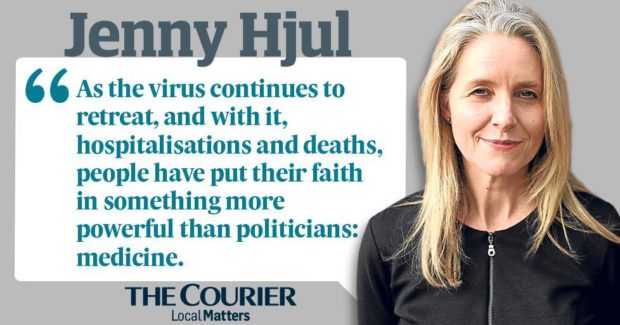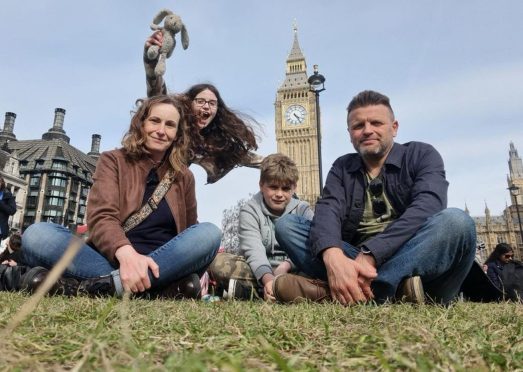How ironic that Scotland should produce the first countrywide study showing that the Covid vaccinations are having a “spectacular” impact on stopping serious illness.
Previous results about vaccine efficacy – also hugely encouraging – have come from clinical trials, but these, from Edinburgh University, demonstrate the effect of the Pfizer and Oxford AstraZeneca jabs in the community.
Within weeks, one shot reduces the risk of being admitted to hospital by more than 81% for the over 80s, a great reason to be optimistic said the lead researcher, Professor Aziz Sheikh.
But optimism does not compute with the Scottish Government. On the same day this happy news about the vaccine roll-out was published, the SNP let it be known Scotland was to remain locked up for the foreseeable future.
The past year has seen the nationalists forge their own response to the pandemic, even when (especially when) it would have made more sense to adopt a whole UK approach, as in last week’s farcical attempt to quarantine international arrivals north of the border.
It is boringly predictable, therefore, that Nicola Sturgeon should seek to apply the brakes here after Boris Johnson unveiled his road map out of lockdown this week.
London’s attempt to broker a common strategy on Monday failed when Sturgeon left a four-nations meeting on easing restrictions after just 15 minutes.
Her excuse that she had to attend her televised Covid briefing sounded petulant, and her eye-rolling when quizzed by a reporter was plain rude.
This now matters much more than she seems to realise. For months, much of Scotland has suffered the strictest curbs on its liberties.
Despite transmission rates here being as low or lower than the rest of Britain, our hospitality trade has been shut since October, our shops since Boxing Day.
Disrupted schooling
Schooling has been disrupted for the past year and even now only the very youngest pupils are being allowed back into their classrooms, although children represent minimal Covid threat.
The nationalist government has maintained these draconian measures with remarkably little protest from the public. And Sturgeon’s authority has rarely been questioned.
But March 2021 is looking very different to March 2020. And so is the credibility of the first minister. On Monday night, the eve of her announcement on Scotland’s exit, if ever, from the lockdown, she rushed out a statement that had nothing to do with Covid.
In the latest salvo in the battle with her predecessor, Alex Salmond, she again felt it necessary to deny she had misled parliament, a resigning offence if true.
We will hear on Wednesday his evidence to the Holyrood inquiry investigating the government’s handling of complaints against him. He has already published an explosive account of his version of events leading up to his court case last year, where he was acquitted on 13 sexual assault charges. Against this backdrop, Scots are being asked to trust Sturgeon as she dictates the future course of their lives.
Downing Street’s route to recovery was cautious in the extreme, and excessively prescriptive – even issuing orders about hugging (not until mid May at the earliest and then only with friends and family).
Warned not to make plans
But it did at least provide a timetable which, all being well, will see England completely free by June 21. Scotland, on the other hand, has been warned not to make plans for summer holidays, not even domestic breaks.
Newly vaccinated Scots, their eyes smiling above face masks, told the BBC they were looking forward to getting back to normal.
They assumed, as did we all, that vaccination was their ticket to freedom but Sturgeon and her advisers have decreed that Scotland, alone in the UK, will attempt to suppress the virus.
Given that this is impossible because we are still not New Zealand and our police force has bluntly refused to man illegal border patrols, what is her plan?
People are meeting each other
The days of forcing total compliance are long past, as a trip to any outdoor space will prove.
People across Britain are meeting each other, quietly and safely, some possibly behind closed doors, too.
As the virus continues to retreat, and with it, hospitalisations and deaths, they have put their faith in something more powerful than politicians – medicine.
Johnson’s Step 3 of his road map instructs that, no earlier than May 17, people will be encouraged to “make informed personal decisions” and “consider the risks for themselves, taking into account whether they and those they meet have been vaccinated or are at greater risk”.
Scots are unlikely to be granted such licence. We don’t know yet how the Salmond saga will pan out or even who will be in charge by then.
But surely most Britons, whatever side of the border they call home, will have rediscovered the right of all humankind to take responsibility for their own fate.











